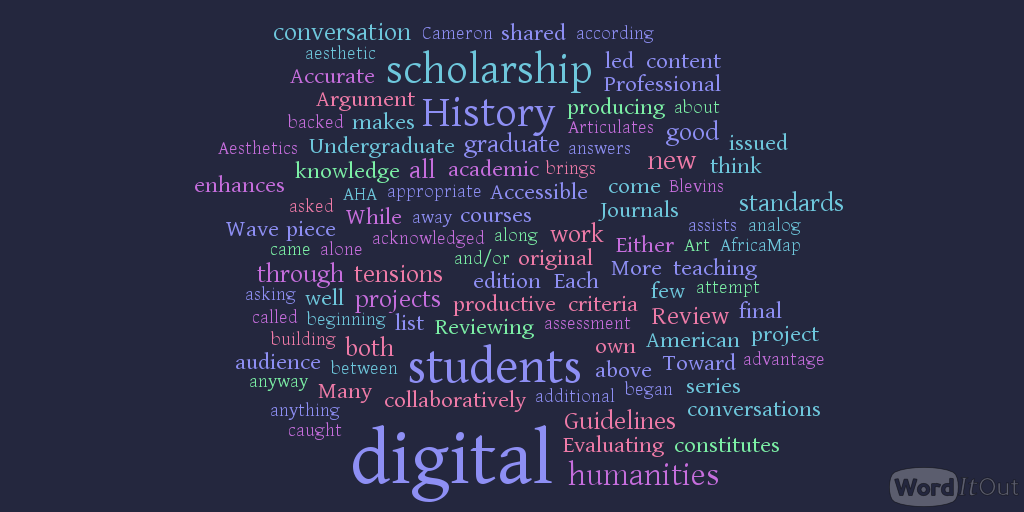I am teaching introductory digital humanities courses this spring at both the undergraduate and graduate level. Both courses have three goals.
- Students will engage in scholarly conversation on the key issues in the field.
- Students will learn to critically evaluate works of digital scholarship.
- Students produce a piece of original digital scholarship.
We recently pivoted from the first goal to the second, while also beginning to chip away at the third. Toward both ends the students have had to think through what makes a good piece of digital scholarship. Fortunately we are not alone in asking that question. While digital humanities journals have been publishing quality work for many years, humanists are still struggling to integrate digital scholarship into existing frameworks of academic recognition.
Cameron Blevins has acknowledged what he’s called “The New Wave of Review” in the digital humanities. This new wave includes initiatives from professional organizations. The MLA has issued “Guidelines for Evaluating Work in Digital Humanities,” since 2000 with the most recent edition emerging in 2012. Just this fall, the AHA released their own series of “Guidelines for the Evaluation of Digital Scholarship.” Journals have caught on as well. The Journal of American History began reviewing websites in June 2001, and renamed the endeavor “Digital History Reviews” in September 2013. The latest edition of the American Historical Review included an exchange on “Reviewing Digital History.
I have asked my students to review all of the above, along with the “Digital Dissertation Guidelines” issued by George Mason University’s History and Art History program. This led to a robust conversation on what constitutes good digital humanities scholarship. Of course, this conversation required us to think about what makes good analog scholarship as well as reflect on what changes, if anything, when you introduce the digital variable.
Each student shared their own list of assessment criteria for digital projects. Then, through discussion, they collaboratively whittled down their list to a few shared standards. Here is what my undergraduates and graduate students came up with.
Undergraduate students
- Either creates new knowledge or presents knowledge in a new way
- Articulates importance
- Takes advantage of the digital medium
- Accessible to appropriate audience
- Professional content and presentation
- Consistent and thoughtful aesthetic argument
- Accurate
Graduate students
- Reasonably accessible for intended audience
- Organization enhances content
- Aesthetics enhances understanding
- Interactivity assists user
- Argument backed with evidence
- Accurate
We are working through a series of digital projects including Voyages: The Transatlantic Slave Trade Database, Visualizing Emancipation, and AfricaMap, evaluating each of these projects according to their criteria. This process brings up tensions between what constitutes academic history, public history, and/or popular history. And these tensions have led to additional productive conversations. Many of the students remain unsettled by a few of these standards but the conversations have all been productive, and my teaching style usually has more to do with clarifying tensions than offering answers anyway.
All of this is building toward their final project where the students will be charged with producing a work of original digital scholarship either individually or collaboratively. Perhaps the real test of the above standards will come when I attempt to use them in producing their final project grades.
More on that to come.




